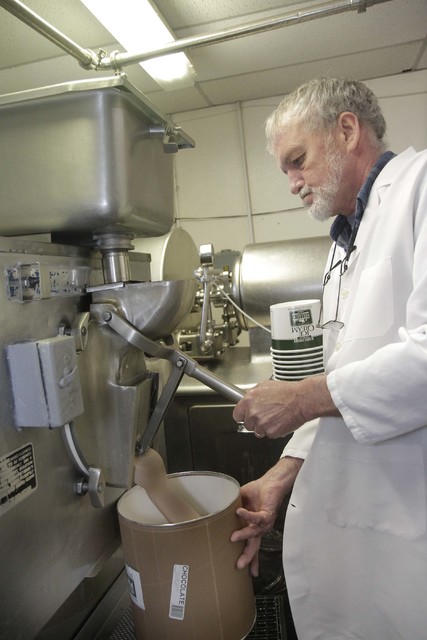






KINGSTON TWP. — Milk, sugar, cream, butterfat and flavorings — the recipe for The Lands at Hillside Farms ice cream is simple and sweet.
The “keep it simple” method for making ice cream has served the dairy farm well — earning it the title as one of the Back Mountain’s sweet spots for over 35 years.
“We sell about 22,000 half-gallon containers of ice cream annually at the Dairy Store,” said Chet Mozloom, executive director of The Lands at Hillside Farms at 65 Hillside Road in Shavertown. “The ice cream parlor uses nearly 7,000 three-gallon containers of ice cream annually.”
So what is the secret that draws in ice cream connoisseurs from across the region, as well as from neighboring states?
“Butterfat,” John Shorts, production manager at The Lands at Hillside Farms said. “We use 14 percent butterfat where many of the cheaper brands of ice cream use about 10 percent.”
The butterfat gives the frozen treat a smooth, creamy texture, Shorts said.
But, patrons should not discount the fresh ingredients and a slow churning process that whips the right amount of air into the ice cream base, adding to the product’s density.
Churning
It all starts with fresh milk from area dairy farms, Shorts said.
The Lands at Hillside Farms’ dairy herd cannot produce enough milk to satisfy the demand for ice cream, Shorts said.
“We use the milk produced from our cows for the Gold Label Milk and to make butter,” Shorts said.
A recent delivery of 800 gallons of milk is stored in a second holding tank, separated from the milk the farm’s dairy cows produce.
The milk is pasteurized at a temperature of about 171 degrees and homogenized.
“The homogenization process breaks up the butterfat into small, bee-bee sized particles and evenly distributes it throughout the milk,” Short said.
The liquid then flows through pipes into a large stainless steel tank where it is cooled to 36 degrees. Then, chocolate or vanilla base flavoring is added. An agitator inside the tank slowly mixes the milk and flavoring.
In a separate room, Shorts and Tylor Gallup, an employee, prepare a batch freezer for use. The batch freezer will turn five gallons of the base mixture into nine gallons of ice cream in about seven minutes, Shorts said.
A larger machine called a barrel freezer that sits nearby can yield a continuous flow of several gallons of ice cream at one time.
“The batch freezer only requires two people to operate and is good at making just a couple of gallons,” Shorts said. “The barrel freezer needs at least five people to run because it creates a steady flow (of ice cream) until it runs out of the mixture.”
Shorts turns on the batch freezer and waits a few minutes for the mixture to whip into a thick milkshake-type consistency.
“The batch freezer has a blade that continuously scrapes the inside barrel as the temperature cools down to 22 degrees,” he said.
Shorts, watching the mixture thicken through a spout, determines when the product is ready to pour into three-gallon and half gallon containers.
If he were adding candy or another mix-in, this would be the point of the process where he would do that.
Shorts opens the machine’s spout and a thick chocolate mixture pours out. Shorts gives the full container to Gallup, who puts a lid on it and places it on a cart. Full containers are put in the “hardening room,” which is a giant freezer with a temperature of 10 degrees, Shorts said.
Approval
Even through Shorts may follow a recipe to the “T,” sometimes variations happen.
“Customers will let you know if the ice cream is not right,” he said. “Not enough cherries or too much marshmallow — we listen to them and fix the recipe.”
But the ultimate approval comes when he sees customers enjoying an ice cream while walking around the farm.
The Lands at Hillside Farms ice cream has a reputation to uphold, Shorts admitted.
The farm has been making ice cream since 1978, Mozloom said.
Shorts, who began working at the farm in 1981 as a bottle washer, learned the manual process of making ice cream from Hillside Farms previous owner Will Conyngham. Shorts followed up his mentorship with a two-week “short course” at Penn State University’s main campus.



